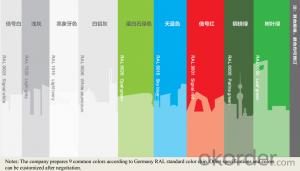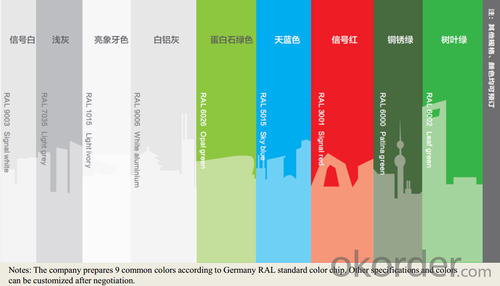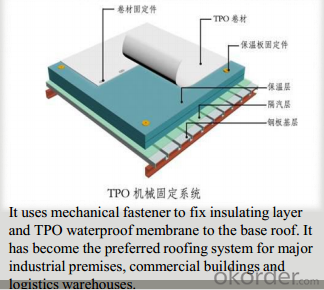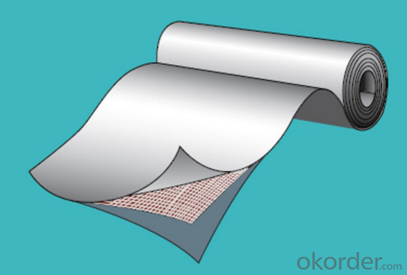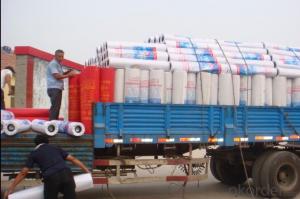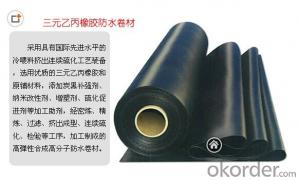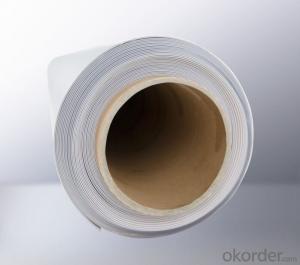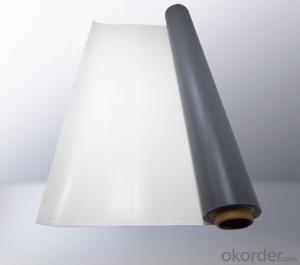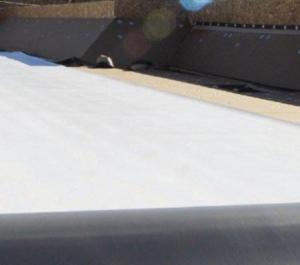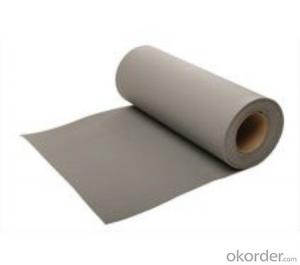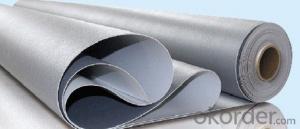PMT Thermoplastic Polyolefin(TPO) Waterproof Sheet
- Loading Port:
- Shanghai
- Payment Terms:
- TT or LC
- Min Order Qty:
- 4000 m²
- Supply Capability:
- 100000 m²/month
OKorder Service Pledge
OKorder Financial Service
You Might Also Like
PMT-TPO is a waterproof sheet, consisting of thermoplastic polyolefin compound resin materials as the base stock, reinforced with fiber backing materials.
This kind of coiled material can be welded, and has good weather resistance and excellent Low-temperature Capability .
There have two kinds of thickness: 1.2mm and 1.5mm.
1. Main Features
Standards
ASTM D6878
Item | Requirement | Test Method | ||
Thickness, min, mm | Sheet-overall | ≥1.0 | ASTM D6878 | |
Coating over fabric or scrim, weathering side only | ≥0.305 | ASTM D751 | ||
Breaking strength, min, N | ≥976 | ASTM D751 | ||
Elongation at reinforcement break, min, % | ≥15 | ASTM D751 | ||
Tensile strength,min, N | ≥245 | ASTM D751 | ||
Brittleness point, max, °C | ≤-40 | ASTM D2137 | ||
Ozone resistance | no cracks | ASTM D1149 | ||
Properties after heat aging | Breaking strength, % min | ≥90 | ASTM D573 | |
Elongation at reinforcement break, % min | ≥90 | ASTM D573 | ||
Tearing strength, % min | ≥60 | ASTM D573 | ||
Weight change (mass), max % | ≤±1 | ASTM D573 | ||
Linear dimensional change, max, % | ≤±1 | ASTM D1204 | ||
Water absorption, max, mass % | ≤±3.0 | ASTM D471 | ||
Factory seam strength, min, N | ≥290 | ASTM D751 | ||
Weather resistance | Visual inspection | - | ||
2. Packaging
Rolled with hard materials and packed with plastic bags or woven bags.
Thickness | Roll Size | Rolls/Pallet | Pallets / 20’ Container |
1.2 mm | 15 m2 | 25 | 20 |
20 m2 | 25 | ||
30 m2 | 25 | ||
1.5 mm | 15 m2 | 25 | |
20 m2 | 25 | ||
30 m2 | 20 |
3. Applications
Various roofing waterproof projects, such as industrial and civil buildings, public constructions;
Full adhered system for concrete substrate or mechanically attached systems.
4. Advantages
Weather resistance and durability;
Excellent weld ability;
No any crisp agents to prevent materials brittleness;
White-based light-color and smooth surface with high reflection, energy saving and anti-dust functions;
Use heat welding for the seam areas to form a reliable seamless waterproof layer.
Intermediate enhanced polyester mesh fabric to have high tensile strength, fatigue resistance and penetrating resistance suitable for mechanically attached roofing systems;
Excellent the same high and low temperature resistance as rubber materials which can keep flexible at -50° C and keep mechanical strength in high temperature;
Excellent chemical resistance to acids, bases, and restaurant exhaust emissions;
Dimension stability;
5. How to Constrution TPO sheet?
For Mechanically Attached Roofing System
Before application, spread TPO membranes on substrate in advance. Install TPO membranes perpendicular to steel deck ribs on the substrate without distortions according to the flange. The overlapping width is 120 mm. The minimum overlapping distance of membrane short side direction is 50 mm. Fasteners are installed according to designed position. Hot-air welding is adopted for laps with 40 mm welding width.
For Fully Adhered Roofing System
Before application, spread TPO membranes on substrate in advance. Install TPO membranes on the substrate without distortions according to the flange. The overlapping width should be more than 50 mm. Hot-air welding is adopted for laps with 40 mm welding width. Professional adhesives need to be used on both underside and substrate surfaces to adhere and maintain.
For Ballasted Roofing System
Before application, spread TPO membranes on substrate in advance. Install TPO membranes on the substrate without distortions according to the flange. The overlapping width should be more than 50 mm. Hot-air welding is adopted for laps with 40 mm welding width.
6.Storage
PMT-TPO material should be stored in well-ventilated place and avoid being exposed to the sun or rain. The temperature in stored places can not be higher than 45° C. It only can be put horizontally in five-level. It has to be avoided acid, alkali, oil and organic solvents. The shelf life is 1 year.
7. Transportation
PMT-TPO material should avoid inclination or lateral drift during transportation. When necessary, covering with felted fabric.
8. Attentions
TPO membranes reflect heat and light, wearing protective clothing (long-sleeved shirt, long-barreled trousers), and wearing a filter to protect the skin and eyes from UV-induced damage.
Security measures for roof perimeter are necessary when application. Sheet surface is slippery when wet, taking care to avoid slide.
Sealants and adhesives are flammable containing solvents. They will be dangerous when exposure to heat, even have the possibility to catch fire and explode.
Sealants, adhesives, cleaners should be avoided contacting with skin and eyes.
No smoking during application.
9.Certificate:
Meanwhile, it has obtained FM certificate of the US, CE certificate of EU, and Gost-R certificate of Russia with its more stable properties and excellent performance.
- Q: Can a waterproofing membrane be used for podium decks or plaza areas?
- Podium decks or plaza areas can benefit from the application of a waterproofing membrane. It is highly recommended to utilize this protective layer in order to safeguard the underlying structure from water-related harm. Given their exposure to the elements, podium decks and plaza areas are susceptible to water infiltration. By implementing a waterproofing membrane, water seepage into the lower layers can be effectively prevented, thus ensuring the long-lasting durability and structural integrity of the deck or plaza. Furthermore, this waterproofing membrane is also capable of shielding spaces beneath the deck or plaza, such as basements or parking garages, from potential water damage. Therefore, it is crucial to select a top-notch waterproofing membrane specifically designed for outdoor purposes, and to carefully adhere to the manufacturer's instructions regarding proper installation and maintenance.
- Q: Can a waterproofing membrane be used in areas with extreme weather conditions, such as hurricanes or snowstorms?
- Yes, waterproofing membranes can be used in areas with extreme weather conditions, including hurricanes and snowstorms. These membranes are specifically designed to provide protection against water penetration and are built to withstand harsh weather elements. They are often used in construction projects to ensure the durability and longevity of structures in such environments.
- Q: How are waterproofing membranes installed?
- Waterproofing membranes are installed to protect buildings and structures from water damage. The installation process typically involves several steps. First, the surface that is to be waterproofed must be properly prepared. This usually involves cleaning the surface and removing any debris or loose materials. It is important to ensure that the surface is smooth and free of any irregularities or cracks. Next, a primer is applied to the surface. This helps to create a strong bond between the membrane and the surface. The primer is typically applied using a brush or roller, and it is allowed to dry completely before moving on to the next step. Once the surface is primed, the waterproofing membrane can be installed. There are several different types of membranes available, including sheet membranes, liquid membranes, and peel-and-stick membranes. The specific type of membrane used will depend on the needs of the project and the surface being waterproofed. For sheet membranes, the material is typically unrolled and carefully positioned over the primed surface. It is important to ensure that the membrane is properly aligned and that there are no wrinkles or air pockets. The membrane is then pressed down firmly to create a strong bond with the surface. Liquid membranes are typically applied using a brush or roller. The liquid is spread evenly over the primed surface, and multiple coats may be applied to ensure a complete and effective waterproofing layer. It is important to allow each coat to dry before applying the next. Peel-and-stick membranes are the easiest to install. The backing is peeled off the membrane, and it is carefully pressed onto the primed surface. The adhesive on the back of the membrane creates a strong bond with the surface. Once the membrane is installed, any seams or joints must be properly sealed. This is typically done using a waterproofing tape or sealant. The goal is to create a continuous and watertight barrier to prevent any water from seeping through. Overall, the installation process for waterproofing membranes requires careful preparation, proper application, and attention to detail. It is important to follow the manufacturer's instructions and to use the appropriate materials and techniques for the specific membrane being installed. By doing so, a reliable and effective waterproofing system can be created to protect the building or structure from water damage.
- Q: Can a waterproofing membrane be used on asphalt roofs?
- Yes, a waterproofing membrane can be used on asphalt roofs. Waterproofing membranes are designed to provide a barrier against moisture, and they can be applied to various types of roofs, including asphalt roofs, to protect them from water damage and leaks.
- Q: How does a waterproofing membrane adhere to the surface?
- A combination of mechanical and chemical bonding is responsible for the adherence of a waterproofing membrane to a surface. Typically, a specialized adhesive or primer is used to apply the membrane, aiding in the creation of a robust bond between the membrane and the surface. Mechanical bonding occurs when the adhesive or primer penetrates the surface's pores, establishing a physical bond between the membrane and the substrate. This guarantees a secure attachment, enabling the membrane to withstand various forces. Chemical bonding is also crucial in the adhesion process. The adhesive or primer contains chemicals that react with the surface, resulting in chemical bonds with the membrane. This chemical reaction produces a durable and long-lasting bond capable of withstanding environmental factors like temperature changes, moisture, and UV exposure. Moreover, the composition of the waterproofing membrane itself contributes to its adhesion. Many membranes are made of materials with inherent adhesive properties, such as bitumen or rubberized asphalt. These materials possess natural tackiness, allowing them to adhere to the surface without the need for additional adhesives or primers. In summary, the adherence of a waterproofing membrane to a surface relies on a combination of mechanical and chemical bonding facilitated by specialized adhesives or primers. This ensures a strong and durable bond, effectively safeguarding the surface against water damage.
- Q: Can waterproofing membranes be used on concrete countertops?
- Yes, waterproofing membranes can be used on concrete countertops. These membranes are designed to create a barrier that prevents water from seeping into the concrete, protecting it from damage and increasing its lifespan.
- Q: What is the warranty or guarantee for a waterproofing membrane?
- Different manufacturers and products have varying warranties or guarantees for waterproofing membranes. Typically, a warranty is expected for a waterproofing membrane to ensure its performance and durability. This warranty covers defects in materials or workmanship and guarantees that the membrane will remain waterproof for a specific period. The warranty length can vary based on the quality and type of the membrane, ranging from a few years to several decades. Some manufacturers offer a limited warranty, which may have certain conditions or limitations. For instance, it may only cover the replacement of the membrane, excluding additional costs like labor or damage to other parts of the structure. Before purchasing a waterproofing membrane, it is crucial to thoroughly read and comprehend the warranty's terms and conditions. This will give you a clear understanding of the coverage, exclusions, and any specific requirements or maintenance guidelines needed to maintain the warranty's validity. In addition to the manufacturer's warranty, it is advisable to hire a reputable and experienced contractor for the membrane installation. Many contractors also provide their own warranty or guarantee on their workmanship, offering an extra layer of protection and assurance. Overall, the warranty or guarantee for a waterproofing membrane is a significant aspect to consider when choosing a product. It provides peace of mind and ensures protection against potential defects or failures in the membrane, instilling confidence in the long-term performance and durability of your waterproofing system.
- Q: Can a waterproofing membrane be used in swimming pools?
- Yes, a waterproofing membrane can be used in swimming pools. In fact, it is a common practice to use waterproofing membranes in the construction or renovation of swimming pools to prevent water leakage. These membranes are specifically designed to create a barrier against water penetration, ensuring that the pool remains watertight and free from leaks. The membranes are typically made from durable materials such as PVC, EPDM, or polyurethane, which are resistant to water, chemicals, and UV rays. Additionally, the membranes are flexible and can easily adapt to the shape and contours of the pool, providing a seamless and long-lasting waterproofing solution.
- Q: Can a waterproofing membrane be used for foundation walls and footings?
- Yes, waterproofing membranes are commonly used for foundation walls and footings to prevent water infiltration and moisture damage. They provide an effective barrier against water and help maintain the structural integrity of the foundation.
- Q: Can a waterproofing membrane be used for planter boxes or green roofs?
- Certainly, planter boxes or green roofs can benefit from the utilization of a waterproofing membrane. It is strongly advised to implement a waterproofing membrane in these scenarios in order to avoid any water seepage or harm to the underlying structure. Essentially acting as a safeguard, the waterproofing membrane serves to prevent water infiltration into the planter boxes or green roofs, therefore preventing potential complications like decay, mold, or structural deterioration. By skillfully sealing the area, the waterproofing membrane guarantees that the water remains within the designated area, which in turn fosters robust plant growth and safeguards the structural stability.
Send your message to us
PMT Thermoplastic Polyolefin(TPO) Waterproof Sheet
- Loading Port:
- Shanghai
- Payment Terms:
- TT or LC
- Min Order Qty:
- 4000 m²
- Supply Capability:
- 100000 m²/month
OKorder Service Pledge
OKorder Financial Service
Similar products
Hot products
Hot Searches
Related keywords
